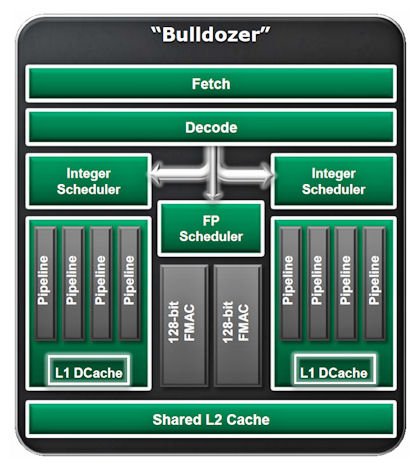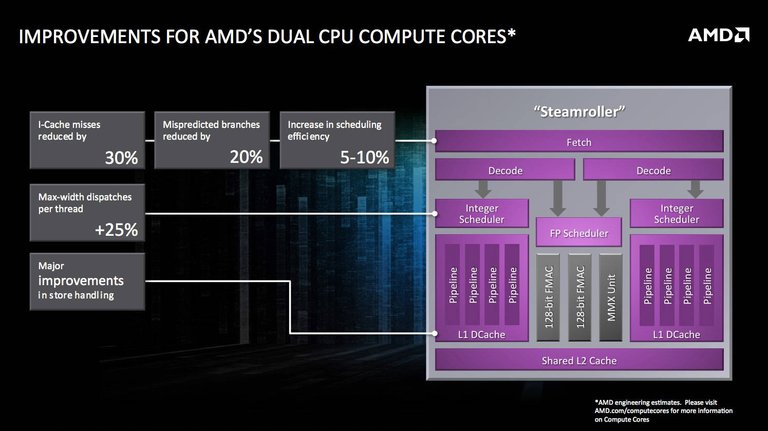Bulldozer (1st Gen, 15th Family) – Released – October 12, 2011
Being the successor of the K10 microarchitecture, AMDs Bulldozer was built from the ground up, basically from scratch and had no relation to previous AMD based CPU designs. Bulldozer is a very complex microprocessor architecture. On paper this new design was a way to increase core count in a cost effective manner all while maintaining best in class performance-per-watt efficiencies and improvements in high performance computing (HPC).
AMD introduces "Clustered Multi-Threading CMT", where some aspects of the processor are shared between 2 threads while others utilize 1 uniquely on their own.
The reasoning behind this kind of processor design was the ability to increase physical cores versus hyper threading (Simultaneous Multithreading SMT). Hyper Threading is a form of having a single CPU core masquerading as multiple cores. Intel uses SMT.
The issue with Bulldozer was the shared aspects of this interesting design. The L2 cache per module was shared between 2 integer cores. It had 2 level Branch Target Buffers, Hybrid predictor for conditionals, Indirect predictor etc. The performance was less than Steller. AMD had to go back to the drawing board and come up with something new. The Bulldozer design was enhanced and modified all while working on a totally new design in the backend.

Piledriver – (2nd Gen, 15th Family) – Released – May 15, 2011
AMD started a brand new microarchitecture from the ground up, which eventually was called ZEN. All while continuing to stay somewhat competitive with the original Bulldozer design. Piledriver was released in 2012. Piledriver was a modified Bulldozer that improved on branch prediction and FPU /integer scheduling. Other major modifications were implemented which granted a clock speed boost of 8-10% with a 15% increase in performance with similar power features. A Piledriver CPU was approx.: 40% faster over a Bulldozer based CPU, based on various design enhancements and increase clock speeds. Piledriver remained as the go to CPU for those that wanted an AMD based CPU. Note below, Jim Keller was hired in 2012 by AMD to lead the next gen design.
Steamroller – (3rd Gen, 15th Family) – Released – January 20, 2014
The successor to the Piledriver, only AMD APUs were built around Steamroller. The desktop and server lines of Steamroller were cancelled. Steamroller was improved by up to 30% (IPC) instructions per cycle over the 1st generation Bulldozer, while maintaining higher clock rates and a decrease in power consumption found in Piledriver.
While AMD was battling it out in the APU front, they were hard at work designing ZEN from the ground up.

Excavator – (4th Gen, 15th Family) – Released – June 1, 2015
The successor to Steamroller, only AMD APUs and servers were built around Excavator. This generation was the final revision of the Bulldozer family line of CPUs.
The Excavator added hardware support for various new instruction sets such as BMI2, AVX2 and RdRand. Excavator increased efficient energy use by up to 30% and processed up to 15% more instructions per clock versus Steamroller. A slight overall improvement for the final family version. This helped keep AMDs APUs competitive against Intel's offerings.
ZEN – (1st Gen, 16th Family) – Released – Q1 2017
ZEN was brand new, built from the ground up. ZEN is much more energy efficient and can execute a considerably more instructions per cycle over its previous generation Bulldozer. Various design aspects include the introduction to SMT, which allows each core to run 2 threads, a redesign of the cache system, and the introduction to Infinity Fabric. ZEN offered up to 52% improvements in IPC instructions per cycle over Excavator. Micro sensors were also introduced into Zen to dynamically scale voltage and frequency. Not to get into too many details, The ZEN microarchitecture helped bring back AMD to fully compete once again in the desktop, enthusiast and server segments. ZEN did catch Intel by surprise as a matter of fact.

ZEN+ – (2nd Gen, 16th Family) – Released – April 2018
ZEN+ was released that offered slightly higher core speed and various design enhancements. Clock for clock, ZEN+ was approx.: 7-8% improvement in performance.
ZEN 2 – (3rd Gen, 16th Family) – Released – Q2 2019
Very little is known about Zen 2. Various rumours and speculation are all over the internet. AMD did release some information, such as Zen 2 will be based on TSMCs 7nm process, will achieve higher CPU frequencies, enhanced power efficiencies and an increase in instructions per clock over ZEN+. ZEN 2 is also said to come out with Infinity Fabric 2, improved execution pipeline, the doubling of the FPU from 128-bit to 256-bit, improved branch prediction, larger Op cache, re-optimized instruction cache, better instruction pre-fetching, halving the energy per operation, doubling the core density etc. Combine all the improvements should bring higher instruction per clock performance over ZEN+. I estimate a performance improvement of up to 20% when combined with design enhancements and frequency increases. Till this day, AMD is keeping ZEN 2's finer details tight lipped.
Jim Keller
Jim Keller is a Microprocessor engineer & Architect. He's known for AMD K7, AMD K8 (lead architect), AMD K12, AMD Zen (lead architect), Apple A4, A5, x86-64 (coauthor) & HyperTransport (coauthor) He's regarded as one of the greatest CPU Architects of our time.
Jim Keller joined AMD in 2012 and led the microarchitecture named ZEN. After his work was done, he left AMD in 2015. 1st generation ZEN successfully launched in 2017 and caught the industry by surprize. He is now the Senior Vice President at Intel.
Please Note: This isn’t financial advice by any means, just my personal opinion with some internet research.